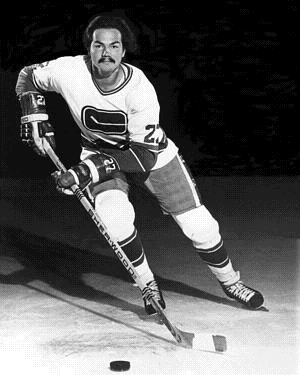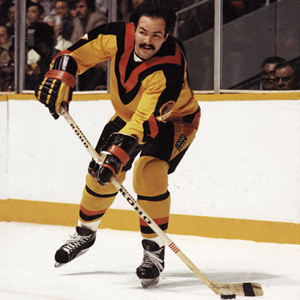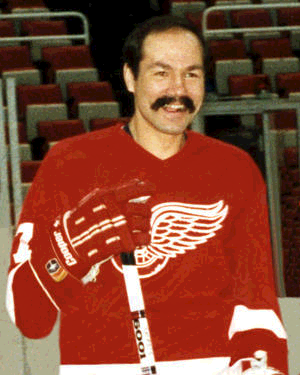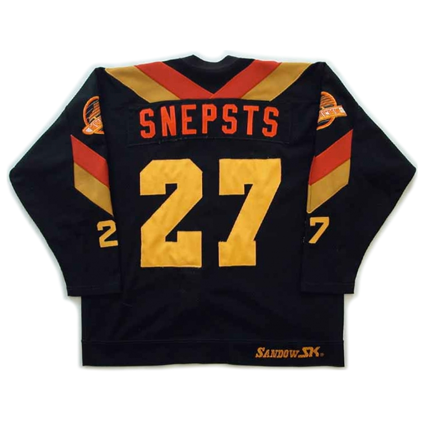Wednesday, December 8, 2010
1980-81 Vancouver Canucks Harold Snepsts Jersey
A rugged, stay at home defenseman, Harold Snepsts played junior hockey for the Edmonton Oil Kings in the Western Canadian Junior Hockey League in 1972-73 and 1973-74 before being drafted by the Vancouver Canucks 59th overall in the 1974 NHL Amateur draft. He was also selected by the Indianapolis Racers of the WHA, but elected to sign with the Canucks of the more established NHL.
He split his games in 1974-75 between the Seattle Totems of the Central Hockey League and the Canucks, with whom he appeared in 27 games and scored his first NHL goal. Snepsts story is not one of goals and points though, as he never had more than seven goals and only scored 30 points once during his long career.
He became entrenched in the Canucks lineup the following season and quickly became popular with the Canucks faithful through is hard work, rugged style, outgoing personality and legendary mustache, which still ranks highly on lists of the best mustaches in league history. Such was Snepsts popularity with the fans in Vancouver, that they would regularly chant "Har-old, Har-old".
In just his third season of 1976-77, his popularity grew as Snepsts made his first NHL All-Star Game appearance as the Canucks lone representative in the first All-Star Game hosted by Vancouver.
In 1978-79 , Snepsts had his best offensive season with career highs in goals with seven, assists with 24 and points, totaling 31. The next season Snepsts experienced the thrill of becoming the first defenseman in Canucks history to score on a penalty shot.
Between 1977 and 1982, Snepsts was named the Canucks top defender four times in five years and increased the rugged nature of his game in 1979-80 when he raised his average penalty minutes from 130 the previous four seasons to 206 the next two years.
In 1982, Snepsts would appear in his second All-Star Game. Later that season the Canucks would go on a run to the Stanley Cup Finals, the only finals appearance of Snepsts career as he was credited for his sound defensive play as the Canucks continued to advance.
After two more seasons in Vancouver, in a highly unpopular move, Snepsts was dealt to the Minnesota North Stars as part of a Canucks youth movement. He set a career high in penalty minutes while with Minnesota in 1984-85 before signing with the Detroit Red Wings for the next three seasons as a free agent.
After rarely missing a game in ten seasons with the Canucks, with seven seasons of over 75 games played and only full season under 68, injuries began to catch up Snepsts during the latter part of his carer, as he never again reached 60 games in his final six seasons of play.
Knee and shoulder injuries would derail his time in Detroit and Snepsts would return to the Canucks as a free agent in 1988 to provide depth and veteran leadership, which helped the Canucks set a club record at the time for fewest goals against in a season.
Looking for that same depth and experience, the St. Louis Blues acquired Snepsts late in the 1989-90 season. He returned to the Blues for the 1990-91 season, which included his 1,000th game on this date in 1990, a 2-1 Blues win over the Red Wings.
Snepsts would retire at the conclusion of the season, having appeared in 1,033 games, scoring 38 goals and 195 assists for 233 points while spending 2,009 minutes in the penalty box.
Today's featured jersey is a 1980-81 Vancouver Canucks Harold Snepsts jersey. From the Canucks inception in 1970-71 to 1977-78 the Canucks wore blue and green jerseys, but in 1978, all that came to an abrupt end.
Before the 1978-79 season the Canucks hired a professional psychologist to redesign their uniforms. The old colors were said to be "too bland, too tranquil and did not inspire emotion." The result was the "V" design, suggesting "victory" according to the designer, one of the strangest, yet most unforgettable jerseys to ever see the ice in an NHL contest.
The bright orange was said to "evoke passion and aggression" while the black road jersey was supposed to instill fear in the opposition.
The Canucks introduced the jerseys, which none of the players had seen prior to the game, at the season opener in Minnesota. As Stan Smyl said, "I've never been ashamed to wear the Canuck's uniform, but that night none of us wanted to leave the dressing room."
They were met with much derision around the NHL and were often referred to as "those Halloween suits". Time has settled on the nickname of "The Flying V" for these jerseys.
The basic jersey produced in 1978 remained in use until the 1984-85 season, but with a few adjustments along the way, such as a change in color for the names on the back, relocating the very unconventional sleeve numbers from the wrists to the shoulders and eventually evolving from one color names and numbers to two colors for both.
Despite others often ranking this as one of the top three, if not the worst, jersey of all time, we are actually fans of the whole concept of trying to design a jersey in an effort to aid your team in victory. It took some bold thinking and a lot of guts for the designer to create this jeresy and then even more for the club to support the concept and stick with it for seven seasons.
The "Flying V" jerseys are a curiosity, as no other team followed them down the same path, leaving the "Flying V" as a truly unique chapter in NHL history.
Today's video feature is a profile of Snepsts, which includes him as one of the seven greatest Canucks of all time and the only defenseman on the list.
Labels:
Snepsts Harold,
Vancouver Canucks
Subscribe to:
Post Comments (Atom)

















No comments:
Post a Comment
We welcome and encourage genuine comments and corrections from our readers. Please no spam. It will not be approved and never seen.